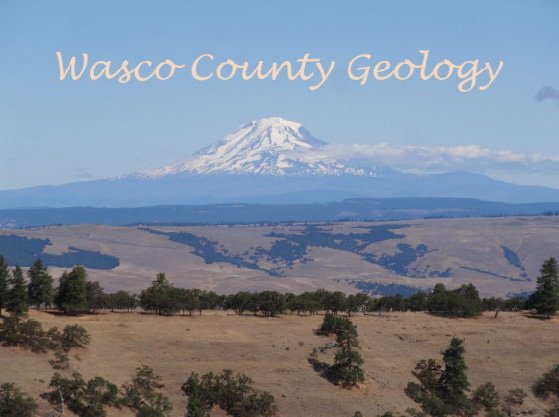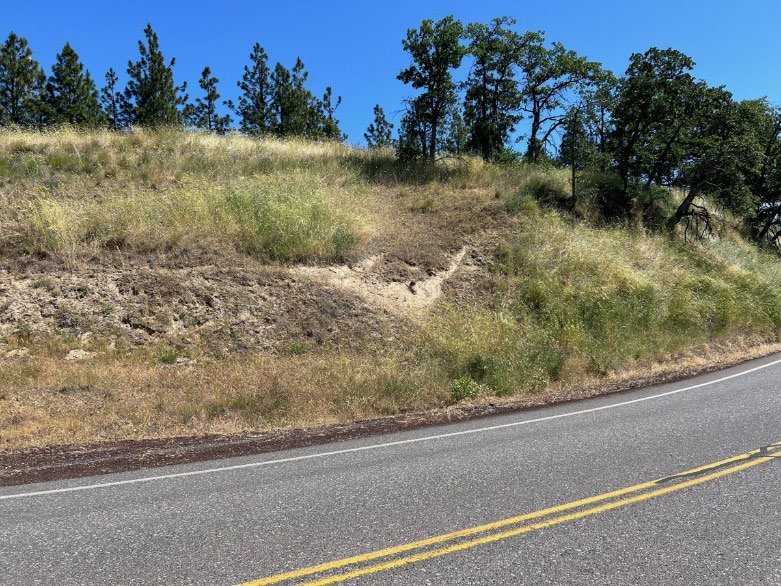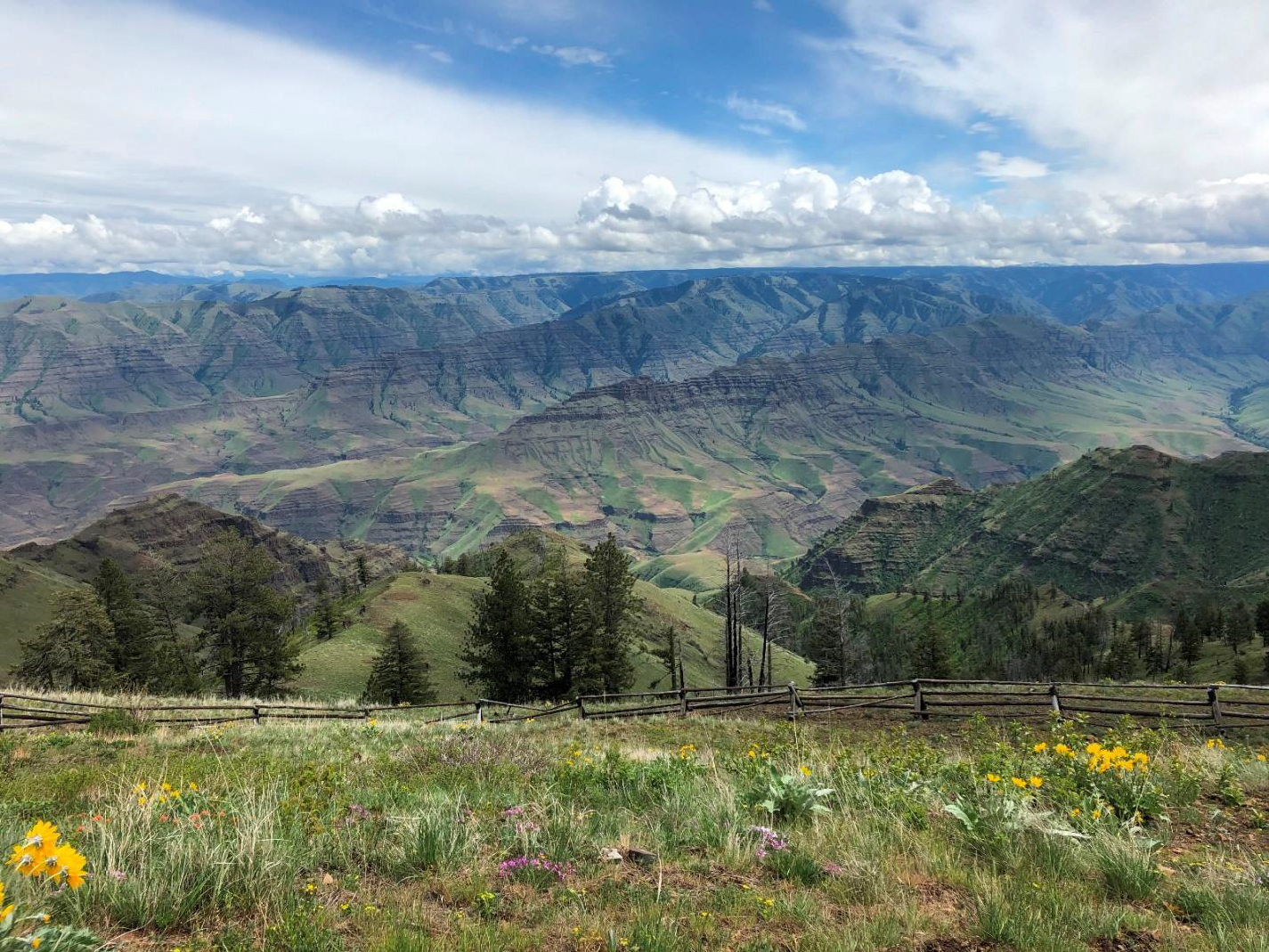
I’ll begin this article with a picture of the Buckhorn Overlook taken on May 18, 2019, when Evelyn Bennett, Julia Lanning and I did the reconnaissance for the Wallowa trip.
We were directed up here by guest field trip leader Ellen Morris Bishop as this is the best overlook of the eastern canyons area for observing the ranks upon ranks of Columbia River Basalt flows that override the exotic terrane rocks of Hells Canyon, Imnaha Canyon and the Zumwalt Prairie through which we had travelled to get there. We are actually looking down into Imnaha Canyon here and Hells Canyon is just over on the other side of the last green ridge you can see. The blue ridge beyond is the eastern wall of Hells Canyon.
(Photos by Carol Hasenberg unless otherwise marked.)

There are only two of the six formations of the Columbia River Basalt Group outcropping in the Hells Canyon and Wallowa area – the Imnaha below and the enormous Grande Ronde above.
The lineation of the canyon walls reflects individual flows of each formation. The grassy bench in the lower portion of the canyon marks the top of the Imnaha.
(Another reason that I’m showing this picture is to contrast this nice partly sunny day in May with the partly rainy and cold ‘Junuary’ day we got for the official trip. In fact, we did not plan to do Buckhorn on the first day of the field trip, but the weather forced us to rearrange the days a bit to save the nicer weather for the day of the hike.)
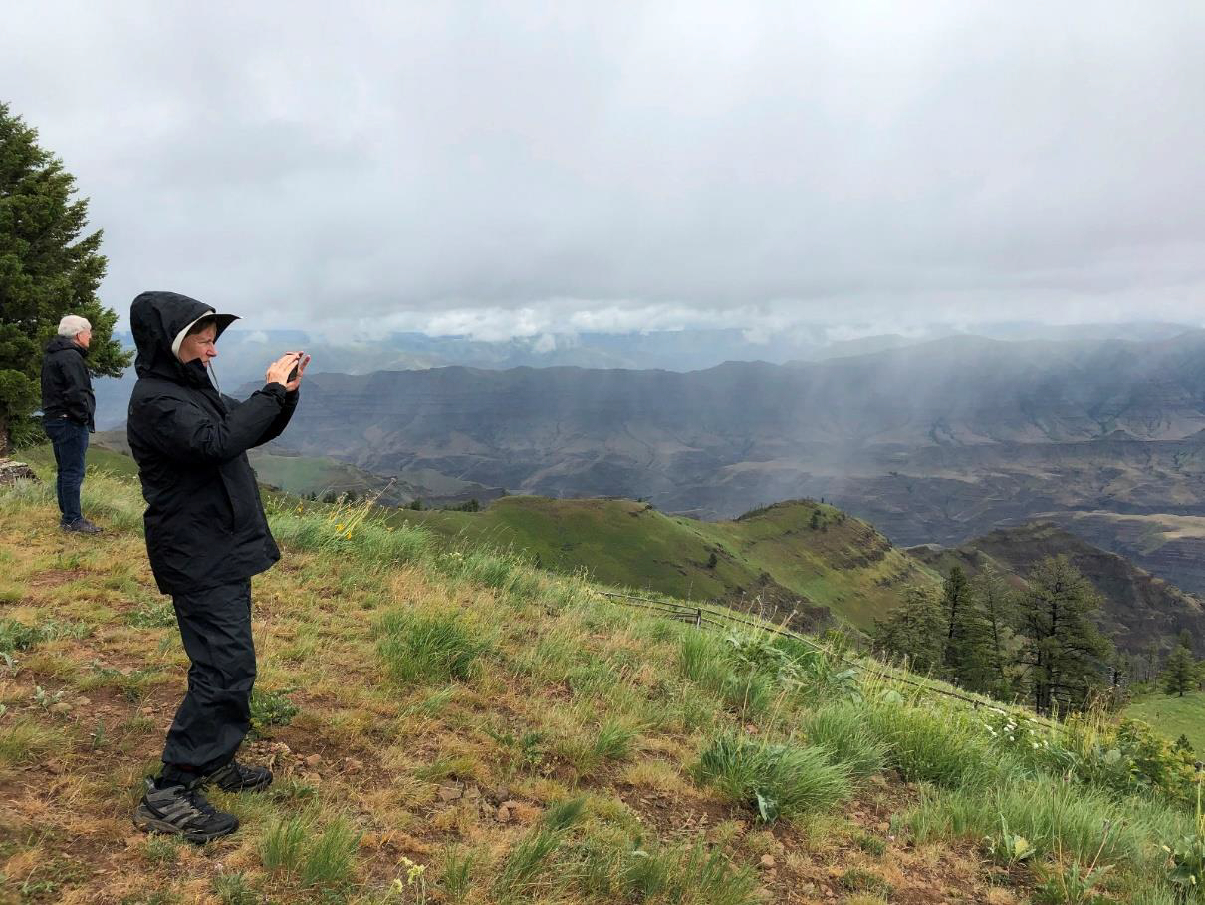
This shot shows the weather on June 20, 2019. A participant, Joyce Mills, is wrapped in winter gear to brave the 39-degree weather.
The confluence of the Imnaha and the Snake occurs just to the left of the prominent ridge in the canyon.
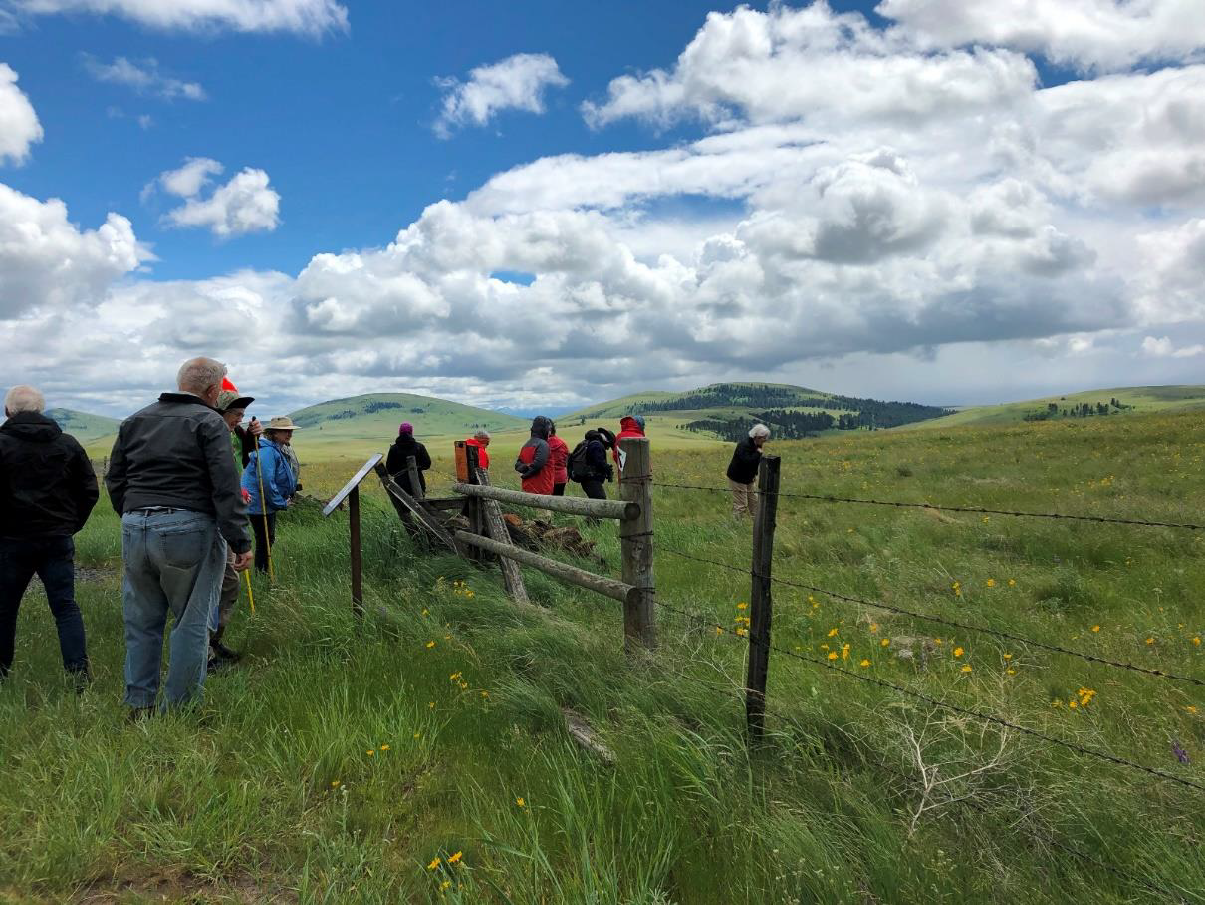
On the way to Buckhorn the most prominent features in Zumwalt prairie are the Findley Buttes shown in the background of this shot taken at the Nature Conservancy Horned Lark trailhead.
The buttes are shield volcanoes from the last of the Grande Ronde flows capping the prairie. Overlying the basalt are various late Miocene ash flow tuffs and windblown loess from the Ice Ages, giving the prairie features a soft, rounded appearance.
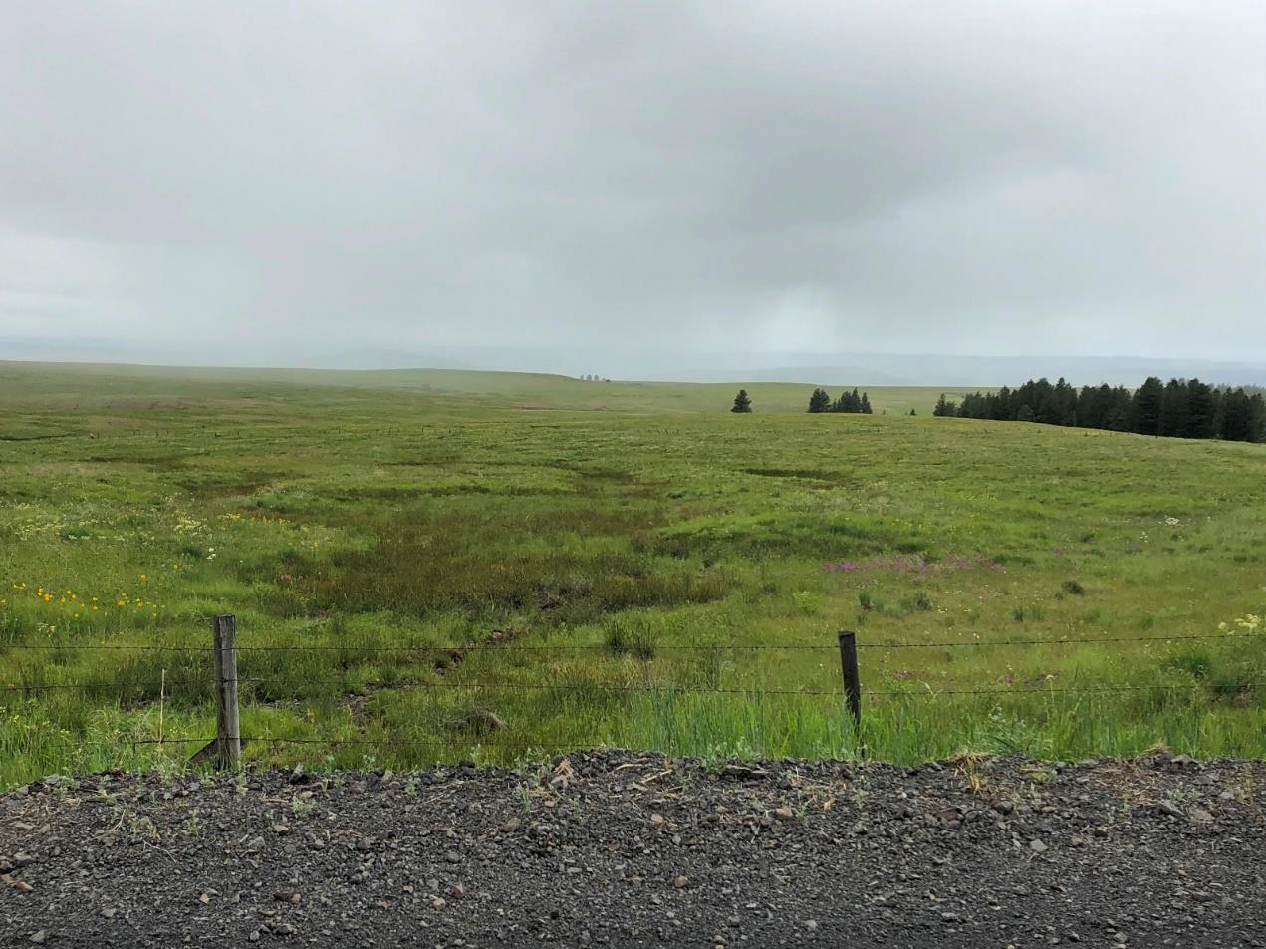
Along the Zumwalt Prairie we also encountered a patchwork of low mounds with rocky drainages between them.
These ‘biscuit scablands’ or ‘mima mounds’ are believed to have been sculpted by generations of pocket gophers, who frequently scurried across the path of the vehicles.
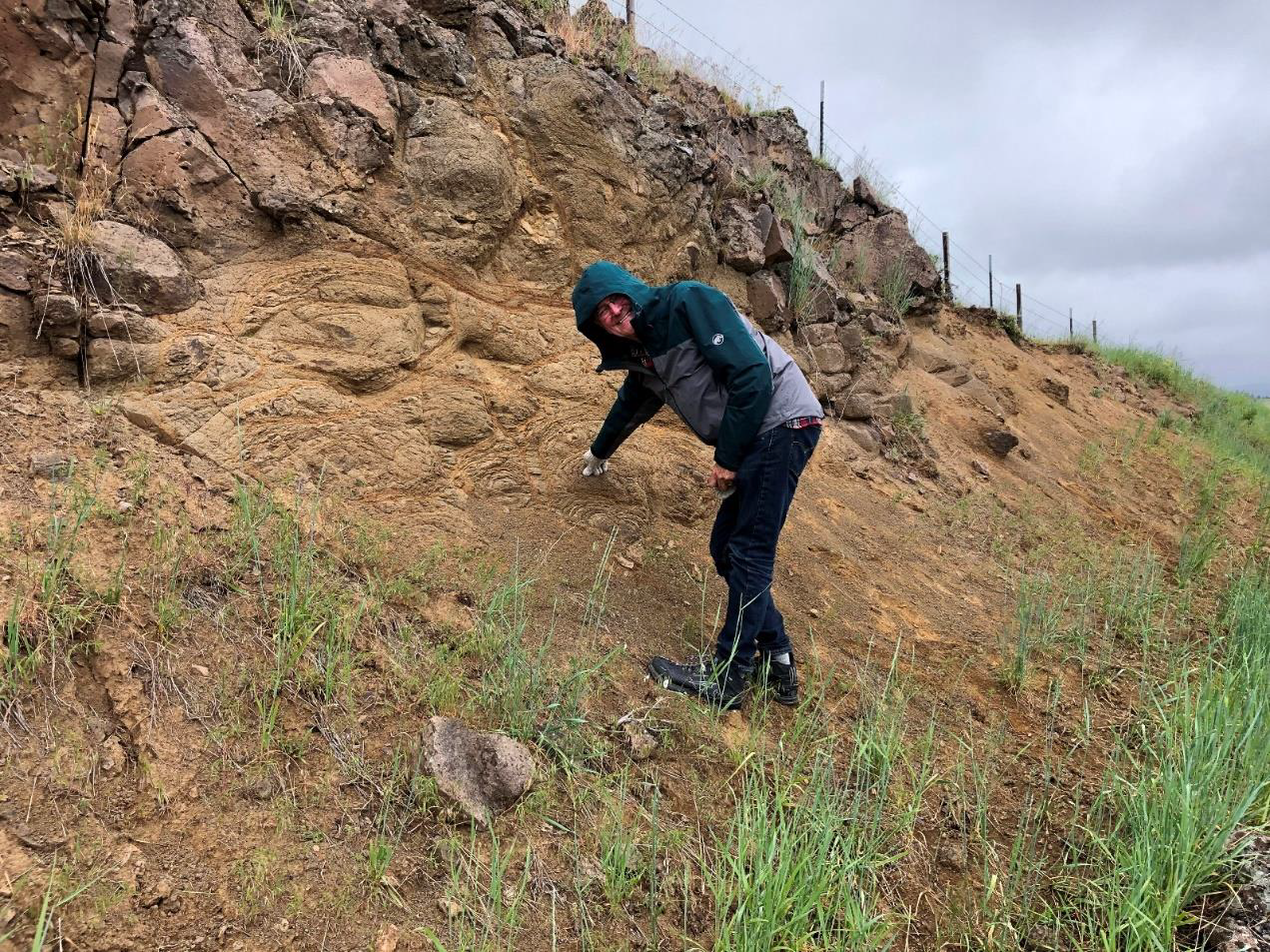
In a couple of roadcuts the Grande Ronde basalt could be spotted on the prairie. Charlie Raymond poses by one of these.

This closeup of the basalt at the roadcut shows the onion-peel characteristic of spheroidal weathering, and is not to be confused with pillow basalts.
Pillow basalts form under water and exhibit radial cracking patterns.

The field trip guide for this part of the trip was photographer Dave Jensen (tan outfit in the center), who took the group to a grove which was an ancient camp of the Nez Perce tribe.
The Nez Perce stripped bark from the trees to mark the camp site, which can be seen on the Ponderosa pines over Dave’s shoulder.
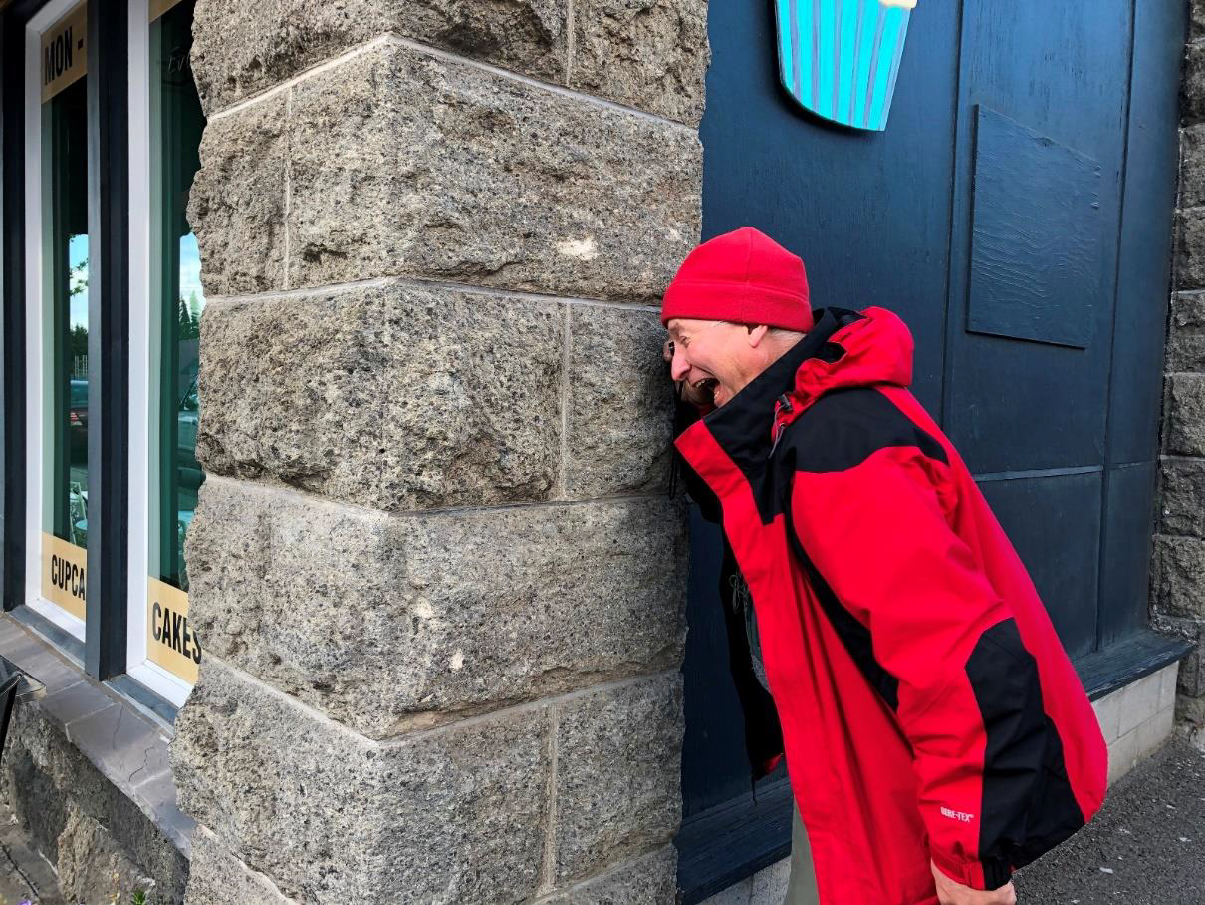
Later that evening my car buddies Dawn Juliano, Larry Jordan and I went into downtown Enterprise to explore several buildings sheathed with Bowlby Stone.
A tuffaceous material erupted during the Grande Ronde flows, Bowlby stone was a popular material because it cut easily when wetted. Larry hams it with the detective work.
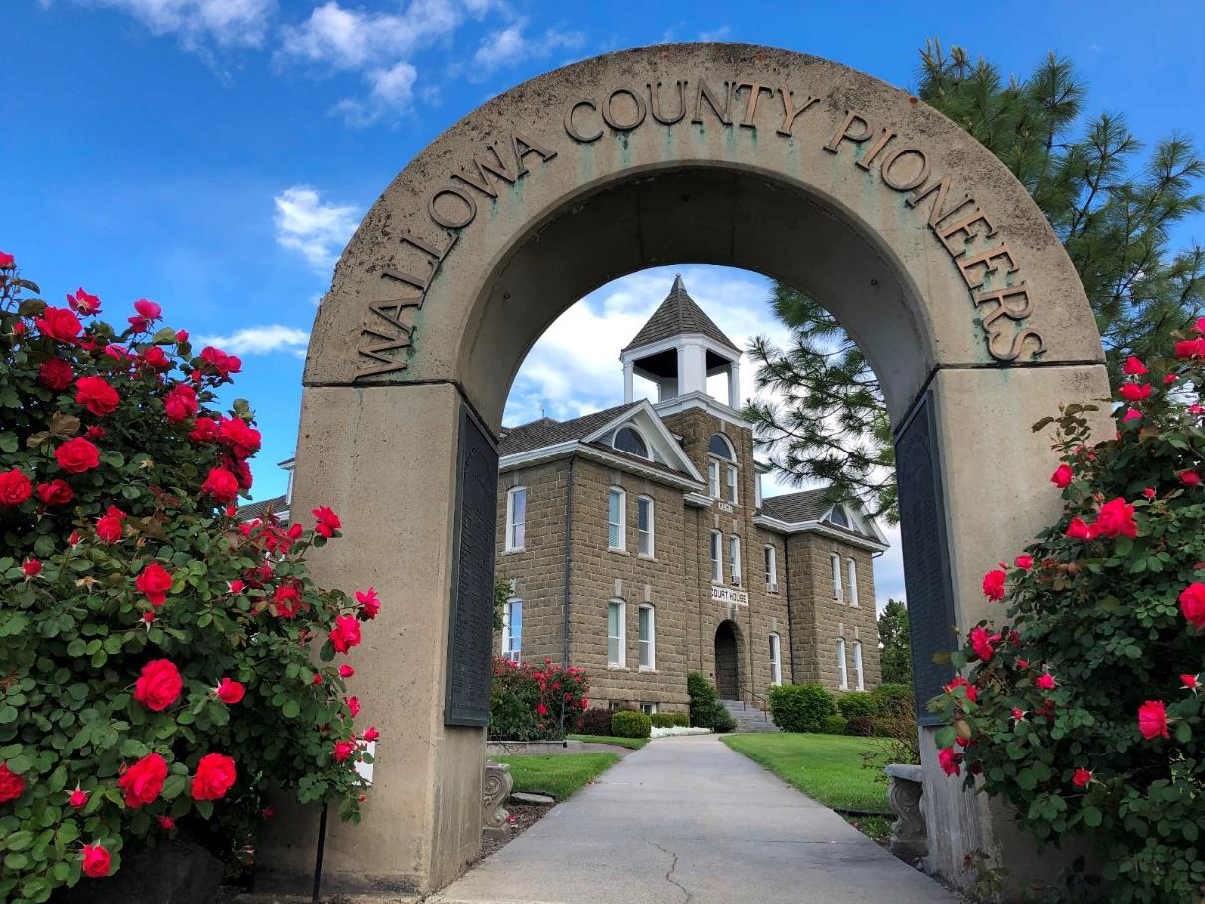
Here is the money shot of the graceful Wallowa County Courthouse which is also sheathed in Bowlby stone.

We also explored the difference in the “fake Bowlby stone”, or concrete made to resemble the color and texture of the real stuff.
Concrete is on the left and real Bowlby stone is on the right.

Next day we organized our carpools to head into Hells Canyon. This drive was approximately 90 miles each way over twisty roads from Joseph.
Stop 1 on Highway 350, just a few miles from Joseph, was a roadcut through a phreatic explosion of Grande Ronde basalt. The explosion was a result of water or mud mixing with the hot lava. Pelagonite was produced in the eruption, and it is characterized by the sulphurous yellow of the mineral limonite.
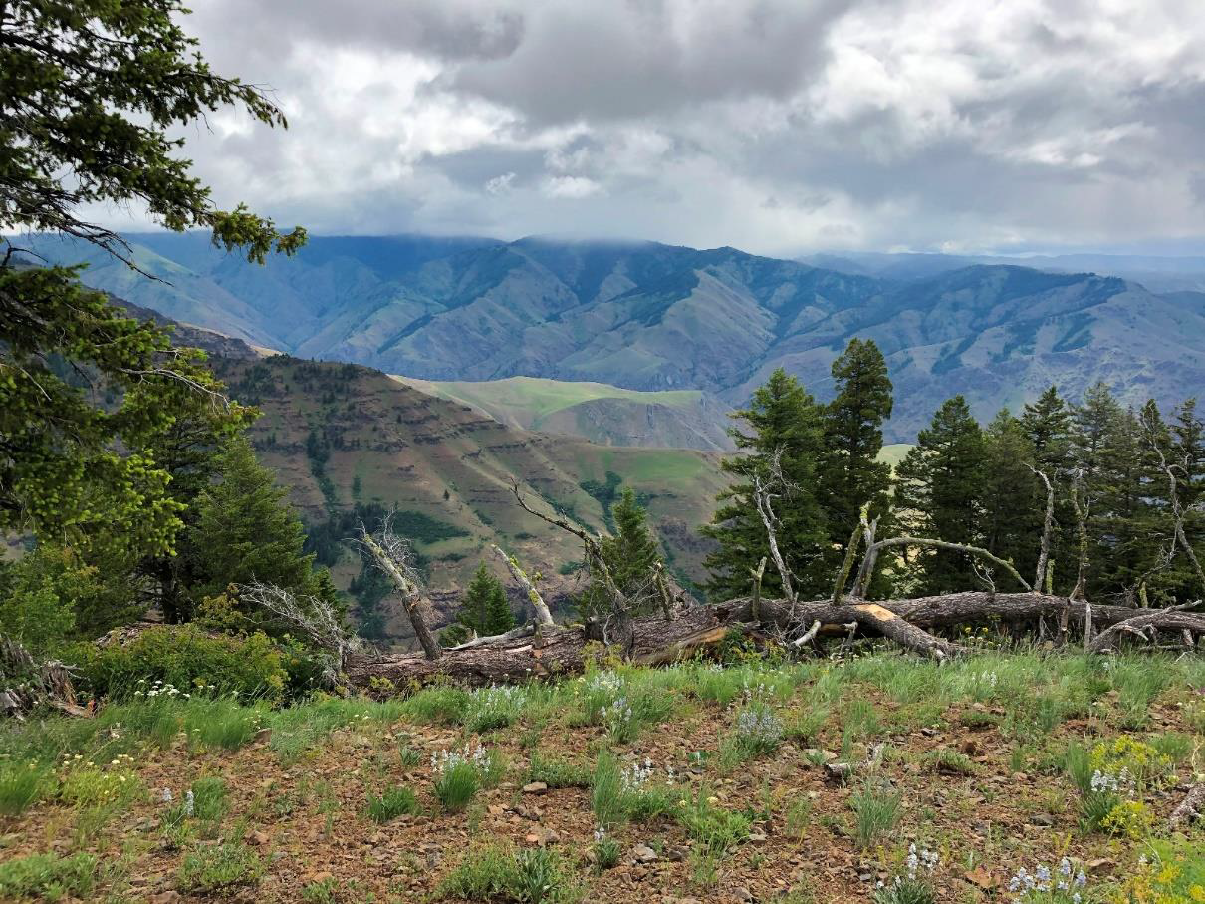
About 40 miles into the drive we stopped at Hells Canyon Overlook. Also a bit of a misnomer, we are looking down a side canyon that terminates in Hells Canyon.
In the closest ridge shown in the picture we see the CBRG. From the overlook we could also see folded swirls of the marble of the Martin Bridge Formation.
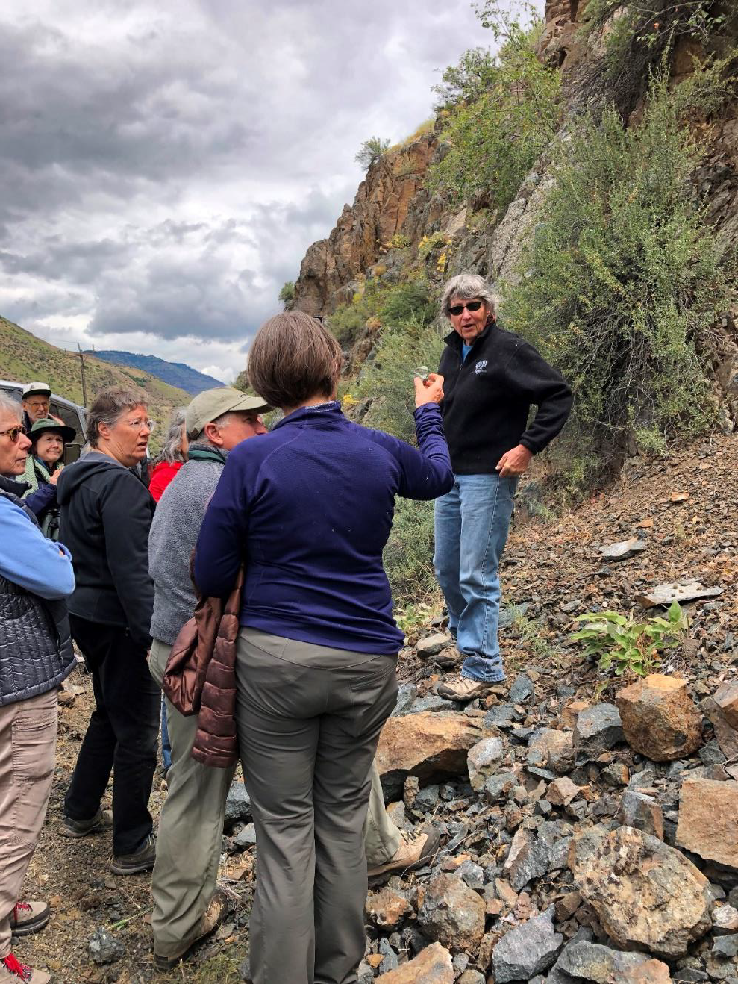
Our first two stops in Hells Canyon were in the first five miles north of Copperfield on the Idaho side, where we viewed the greenstones of the Hunsaker Creek formation.
These were formed when the ancestral volcanic rocks of the Wallowa Terrane, from the Permian period, metamorphosed under the pressure of the accretionary process. Bishop answers some questions from the participants.
For you mineral buffs, in his book Islands and Rapids, Tracy Vallier describes the volcanic rocks of the Hunsaker Creek Formation as metamorphosed to the greenschist facies, changing the composition to keratophyre or quartz keratophyre, rich in the minerals quartz and albite with minor amounts of chlorite, epidote, and calcite.
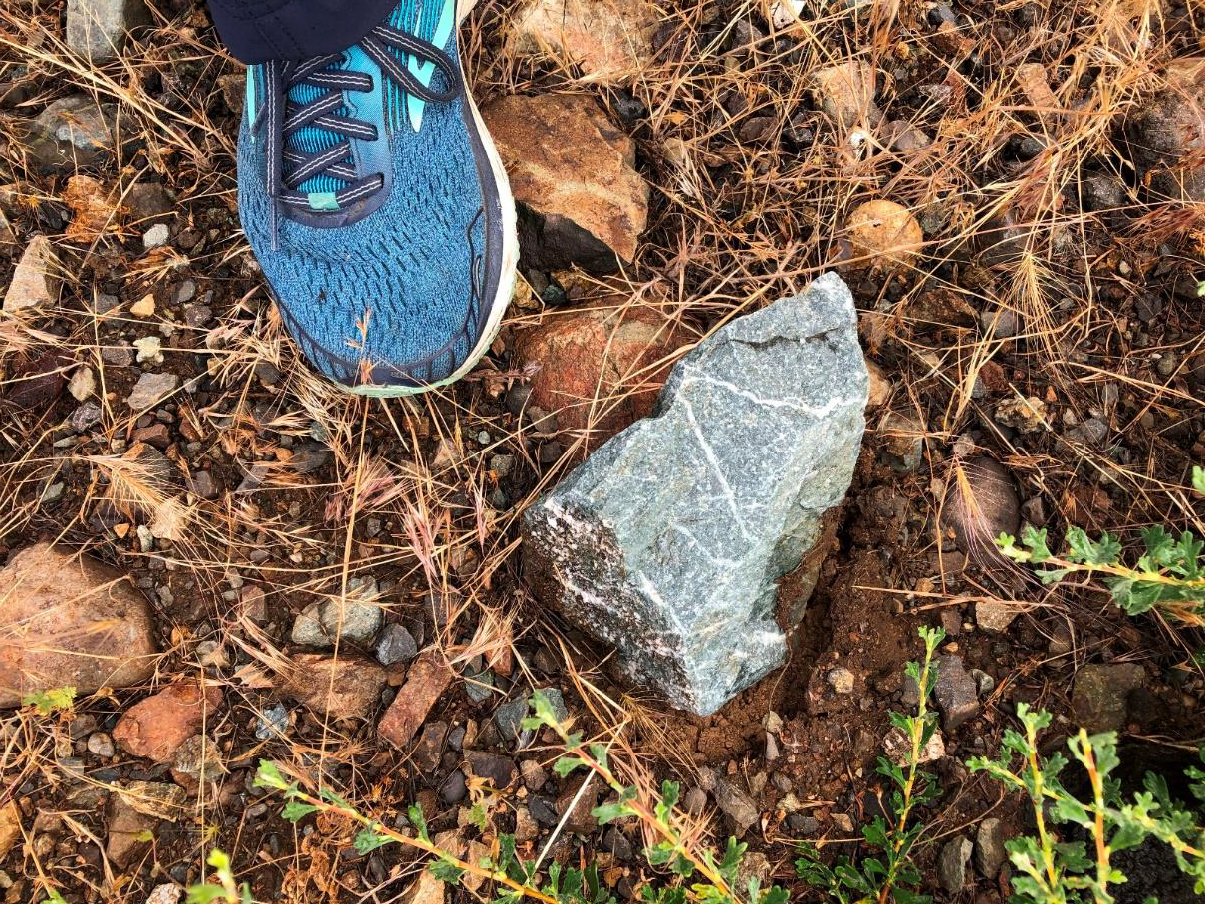
And here is a picture of a greenstone from the first stop.

Looking ahead at Hells Canyon stop 2 we see the swirls of a crag of the marbleized Triassic Martin Bridge Formation of the Wallowa Terrane.
We stopped near there on the return from the canyon to observe some tiny fossil imprints still present in the rock, and cracked some samples open to smell the ‘petroliferous’, or oily-sulfurous smell still present therein from the decay of organic material in the original limestone.

At the third stop we could also look across the Snake River to view some swirling strata of the Martin Bridge Formation on the Oregon side.

Clay Kelleher brought along his muriatic acid with which to test for limestone or other calcic rocks. Here it is doing its thing on the Martin Bridge marble.

This picture was taken of Ellen at the last stop before we reached Hells Canyon Dam, but darned if I can remember what the rock with the phenocrysts was about.
I did not take notes at this stop.
Tracy Vallier says that some flows and sills of the Wild Sheep Creek Formation have glomeroporphyritic textures and shows in the book Islands and Rapids a similar rock from a stop near Hells Canyon Dam.

This shot shows the rugged character of the Wild Sheep Creek Formation outcrops near Hells Canyon Dam.
The Triassic Wild Sheep Creek Formation is more mafic than the Permian volcanic strata of the Wallowa Terrane, and it forms the steepest cliffs of Hells Canyon. Its volcanic rock origins were basalts and andesites, from lava flows, pyroclastic rocks, and breccia from debris flows, and turbidites, intermingled with small amounts of limestone.
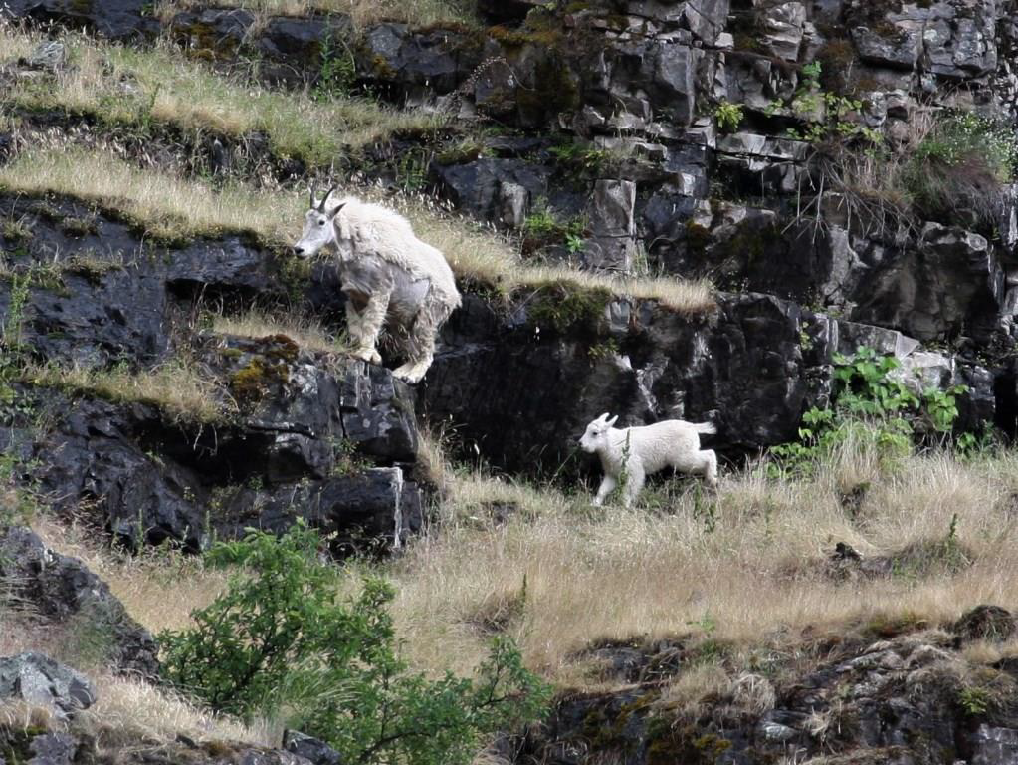
June McAtee took this awesome shot of the mountain goats cavorting near Hells Canyon Dam on the Wild Sheep Creek Formation.

Carole Miles poses near a boulder from the Martin Bridge Formation on the last stop before leaving the canyon.

This shot taken from the Black Point area showcases the rugged beauty of Hells Canyon.
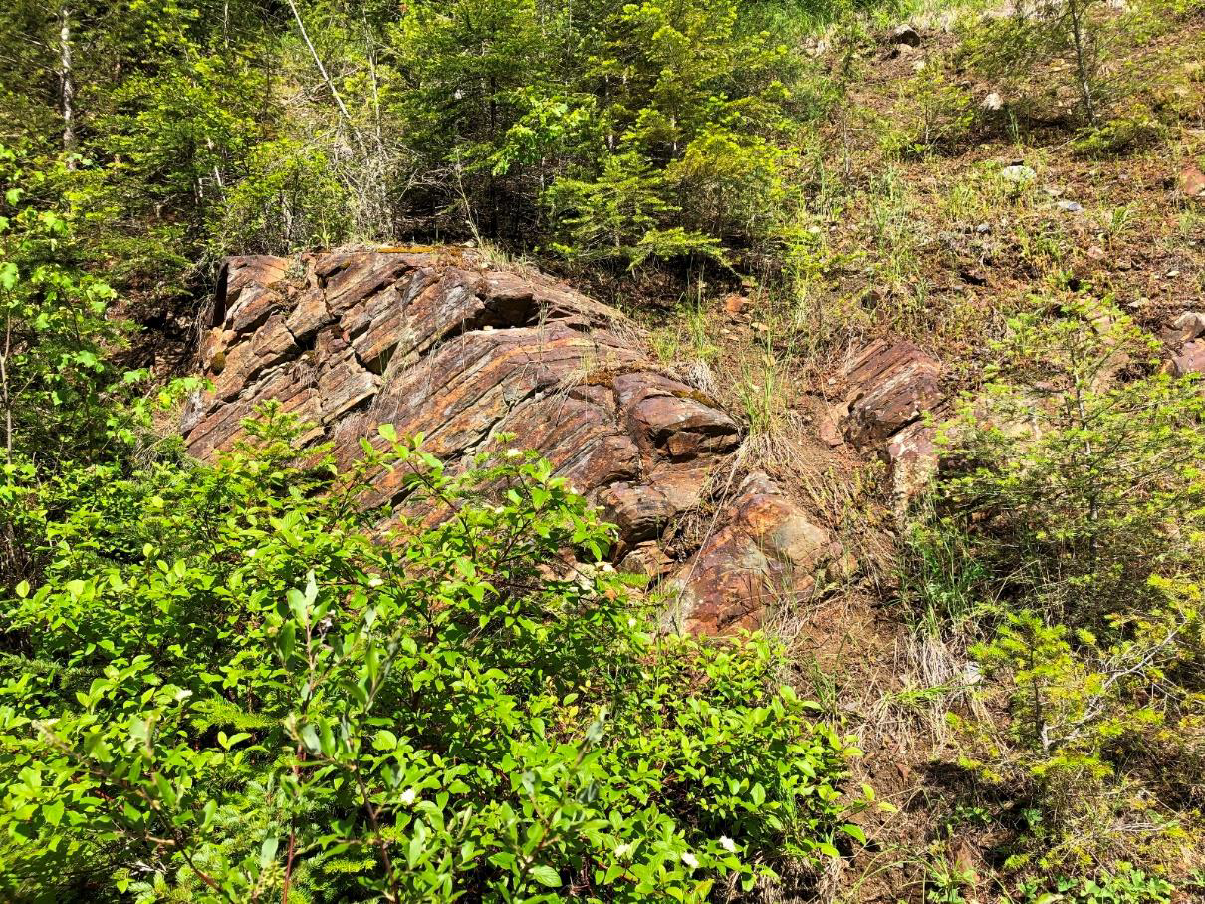
Third day of the trip began with a little drive from Joseph toward the Hurricane Creek trailhead.
On the way up the group stopped at an outcrop of the ‘Lower Sedimentary Series’, sedimentary rocks somewhat older than the Martin Bridge Formation and forming the base of Chief Joseph Mountain.

From the trailhead, the field trip participants diverged into three groups for hiking.
This is my ‘relaxed paced group.’ Woody English, Sheila Alfsen, Dawn Juliano, Jan Kessler, Carole Miles, I think that is Kitty Reed hiding behind Annie English, author Carol Hasenberg, and Bonnie Prange. None of us felt like endangering ourselves on the Falls Creek crossing, which was quite treacherous, so we hung out and looked at rocks in the creek bed and Kitty and Sheila led an impromptu learning session with those rocks. Then Jan Kessler, Carole Miles and I got brave and climbed the (slightly less) treacherous scree path to the falls on Falls Creek.

We were rewarded at the top of the Falls Creek path with this outstanding outcrop of Martin Bridge marble (and also the falls, not in the picture).

After the hikers returned, we jumped into our cars and drove over to the next valley west, the Losteen River valley.
Here we saw this impressive outcrop of Wallowa Batholith granodiorite at the Pole Bridge Picnic Area, where we had a little picnic. This most northerly tongue of the batholith is the most accessible view of 125-140-million-year-old rocks of the stitching plutons that mark the accretion of the Wallowa Terrane onto North America.
During the picnic, the group had a lively discussion of why the moraines of the Wallowa River at the outlet from the Wallowa Mountains, which form Wallowa Lake, were so much bigger and more pronounced than those of the Losteen River, whose mountain valley is nearly straight and much longer than that of the Wallowa River. After much discussion, we covered parameters such as the steepness of the Wallowa River course vs. that of the Losteen, barriers to sediment transport, etc. Also I just thought of another reason – the hardness of the material the glaciers had to carve (i.e., the Wallowa Batholith vs. the sedimentary rocks of the Wallowa Terrane). Any takers?

The final day of the field trip began on the terminal moraine from the glacier that created Wallowa Lake.
Ellen used this portion of the trip to discuss the fragile ecology of the moraine bunch grass prairie – this area is one of the few remaining stands.

Ellen pointed out and described a number of native and invasive species in the prairie at the top of the moraine.
The list included Great Basin wild rye, bunchgrass, buckwheat, pickoon, lupine, cheat grass, timothy, salsify and arnica.
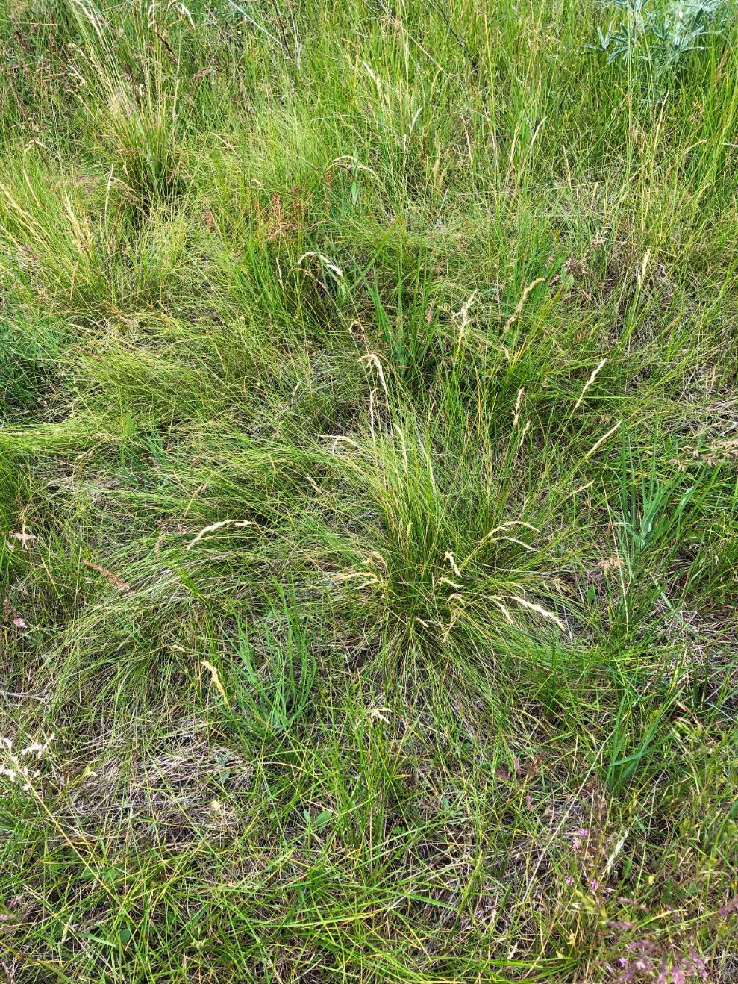
Bunchgrass and native prairie species tend to mass in bunches, leaving space to develop a ‘biological crust’ in between comprised of slow growing moss and lichen.
This protective barrier is easily disturbed by grazing animals.
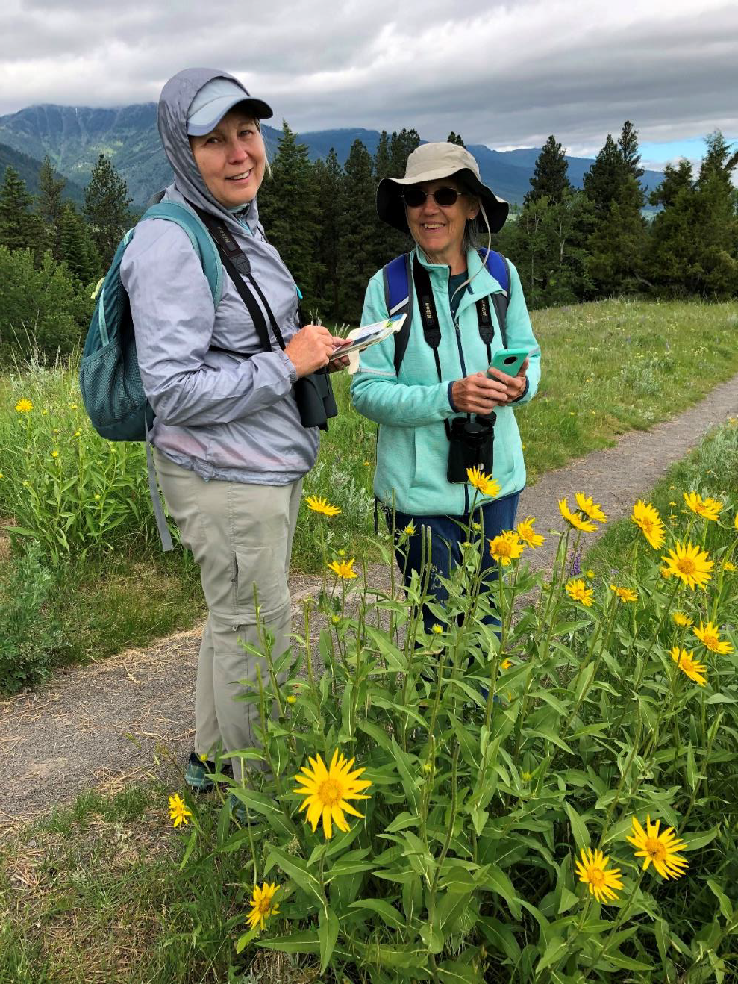
Teresa Meyer and Barbara Stroud shown here plotting an article on the botany of the prairie.

Heading up the Wallawa Lake Tramway, one gets fabulous views of Wallowa lake and the lateral moraines which enclose it like great arms coming from the mountains.
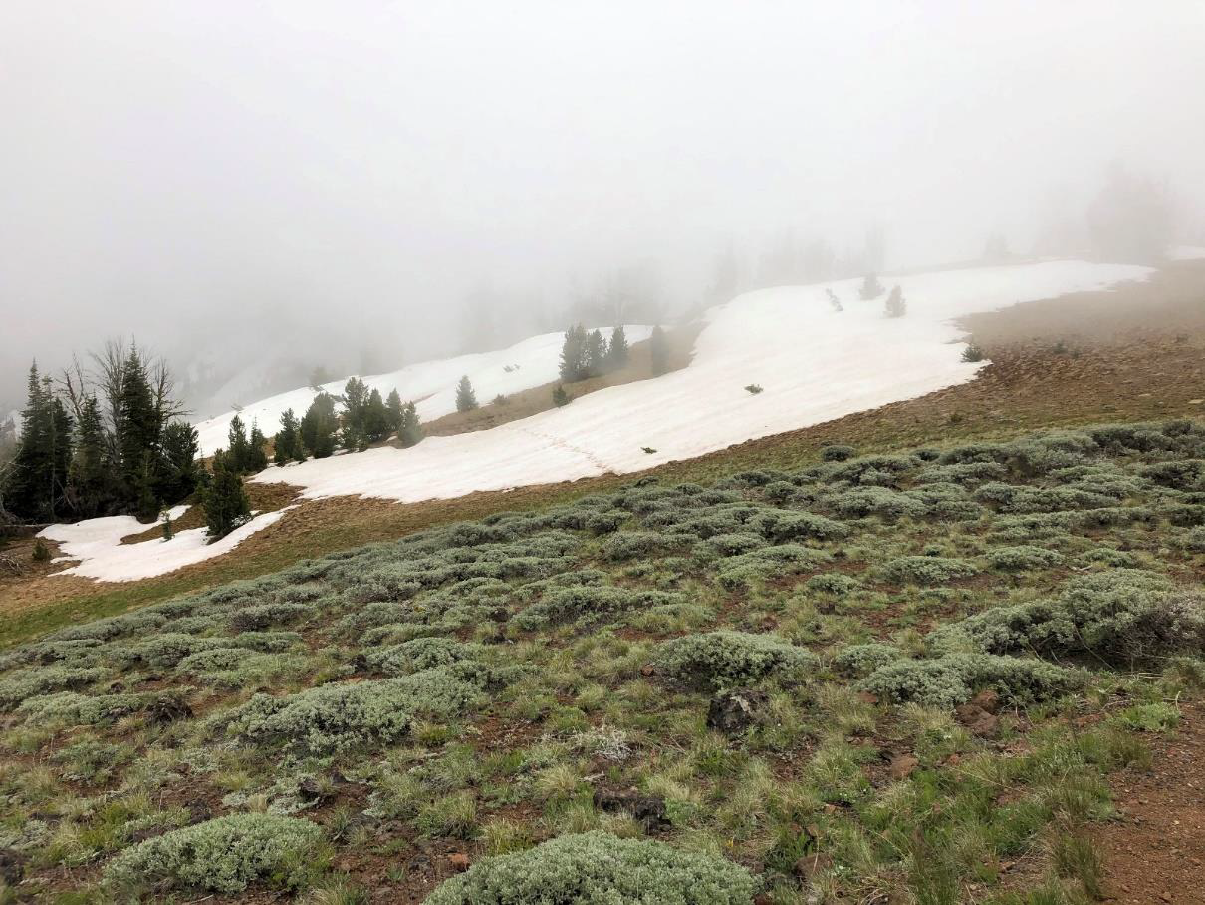
The view at the top of Mt. Howard was not quite as spectacular on this day.

Field trip participants Dawn Juliano, Mary and Charlie Raymond, and Woody English chat with Dave Jensen (orange coat) while waiting for the clouds to lift.
Photo by Annie English.

Nevertheless Kitty Reed and I located ‘Bev’s favorite basalt’ as described to me by Larry Purchase.
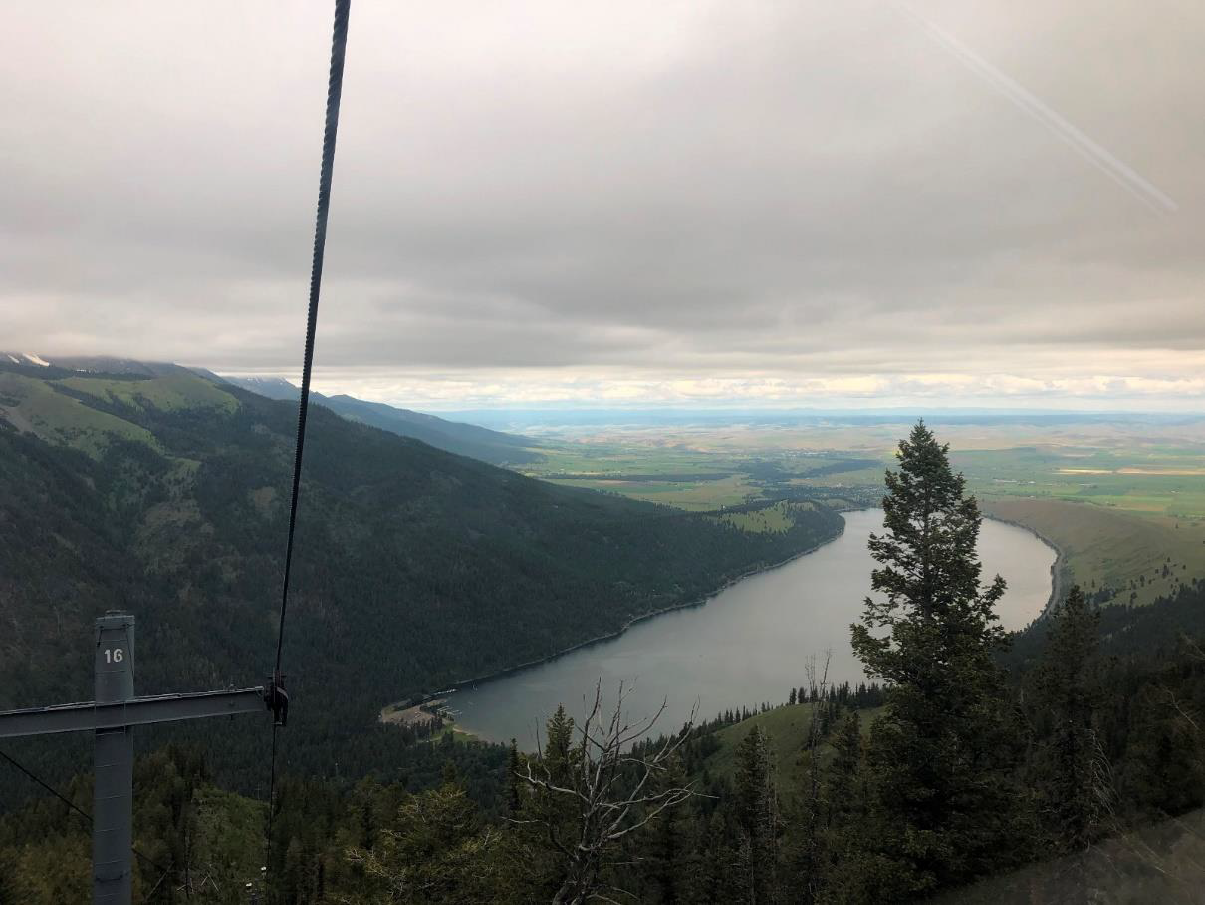
Coming down, the clouds were even lower, but one could see the front of the Wallowa Mountains as defined by the Wallowa Fault.

One could also see a spectacular CRBG dike sticking out of the side of East Peak, the next peak to the south of Mt. Howard.
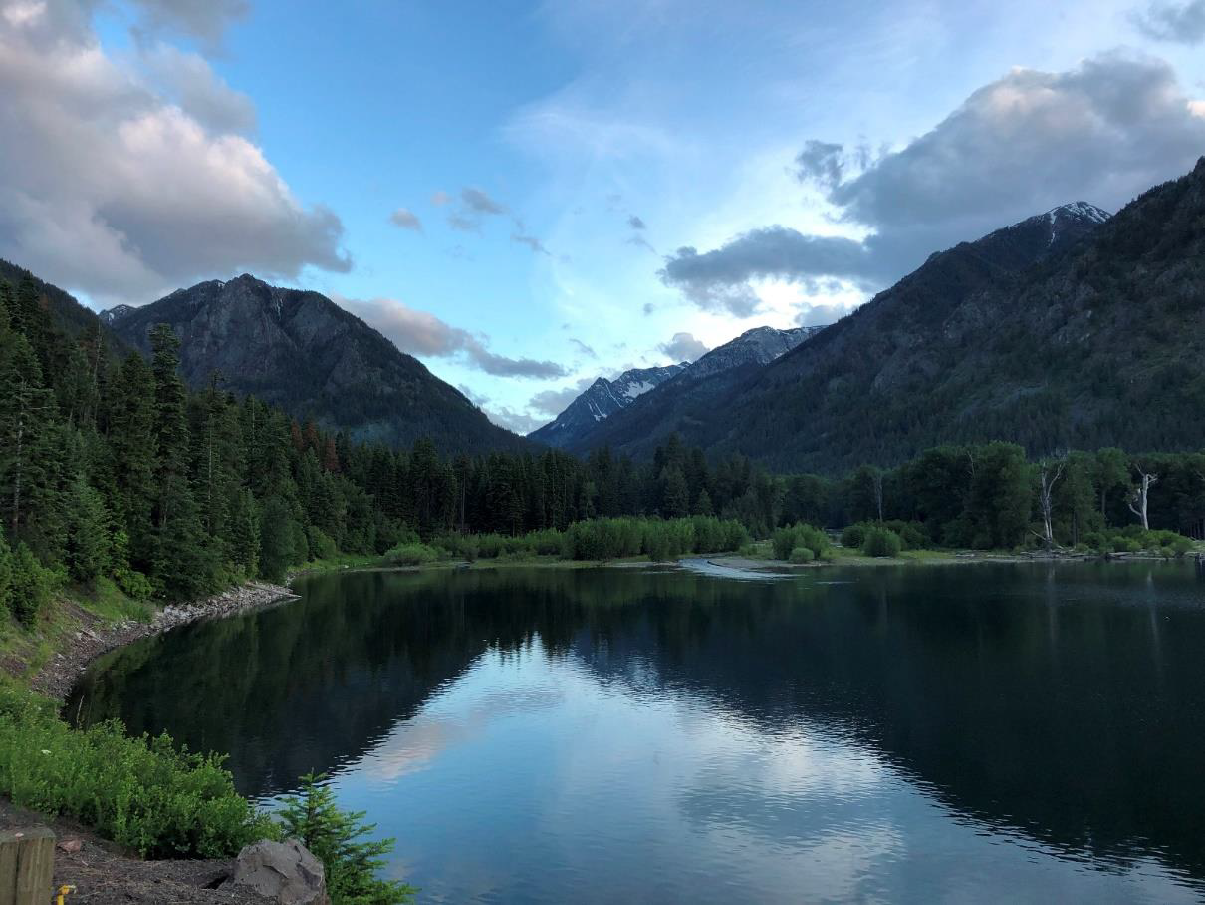
The sun finally set on the end of a fine trip to the Wallowas.






























































